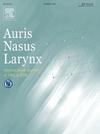胸主动脉手术后肺炎的危险因素
IF 1.5
4区 医学
Q2 OTORHINOLARYNGOLOGY
引用次数: 0
摘要
目的:肺炎是心血管手术后常见的并发症和重要的死亡原因。本研究旨在探讨胸主动脉手术后肺炎的发生率及危险因素。方法回顾性分析2016年1月至2019年12月380例胸主动脉手术患者的病历。根据术后结果将患者分为肺炎组和非肺炎组。肺炎进一步被分类为吸入性肺炎、通气相关性肺炎(VAP)或其他类型。通过单因素和多因素分析确定危险因素。结果住院期间发生手术后肺炎30例(7.9%),其中吸入性肺炎18例(4.7%),VAP 9例(2.4%)。确定的危险因素包括术前声音嘶哑、主动脉弓置换术、麻醉时间较长、插管时间较长、需要气管造口术、术后脑血管疾病、术后喉返神经麻痹。多因素分析提示术前声音嘶哑和气管切开术是住院期间肺炎的独立危险因素。结论本研究确定了胸主动脉手术后肺炎的关键危险因素。这些发现可能有助于识别高危患者和实施预防策略,以减少术后肺炎。本文章由计算机程序翻译,如有差异,请以英文原文为准。
Risk factors of pneumonia after thoracic aortic surgery
Objective
Pneumonia is a common complication and a significant cause of mortality following cardiovascular surgery. This study aimed to investigate the incidence and risk factors for pneumonia after thoracic aortic surgery.
Methods
A retrospective review was conducted on the medical records of 380 patients who underwent thoracic aortic surgery between January 2016 and December 2019. Patients were classified into pneumonia and non-pneumonia groups based on postoperative outcomes. Pneumonia was further categorized as aspiration pneumonia, ventilation-associated pneumonia (VAP), or other types. Risk factors were identified through univariate and multivariate analyses.
Results
Postoperative pneumonia during hospitalization occurred in 30 patients (7.9 %), including 18 cases of aspiration pneumonia (4.7 %) and 9 cases of VAP (2.4 %). Risk factors identified included hoarseness before surgery, aortic arch replacement, longer anesthesia time, longer intubation duration, necessity for tracheostomy, cerebrovascular disease after surgery, and postoperative recurrent laryngeal nerve paralysis. Multivariate analysis suggested that hoarseness before surgery and the necessity for tracheostomy were independent risk factors for pneumonia during hospitalization.
Conclusion
This study identified key risk factors for postoperative pneumonia after thoracic aortic surgery. These findings may aid in identifying high-risk patients and implementing preventive strategies to reduce postoperative pneumonia.
求助全文
通过发布文献求助,成功后即可免费获取论文全文。
去求助
来源期刊

Auris Nasus Larynx
医学-耳鼻喉科学
CiteScore
3.40
自引率
5.90%
发文量
169
审稿时长
30 days
期刊介绍:
The international journal Auris Nasus Larynx provides the opportunity for rapid, carefully reviewed publications concerning the fundamental and clinical aspects of otorhinolaryngology and related fields. This includes otology, neurotology, bronchoesophagology, laryngology, rhinology, allergology, head and neck medicine and oncologic surgery, maxillofacial and plastic surgery, audiology, speech science.
Original papers, short communications and original case reports can be submitted. Reviews on recent developments are invited regularly and Letters to the Editor commenting on papers or any aspect of Auris Nasus Larynx are welcomed.
Founded in 1973 and previously published by the Society for Promotion of International Otorhinolaryngology, the journal is now the official English-language journal of the Oto-Rhino-Laryngological Society of Japan, Inc. The aim of its new international Editorial Board is to make Auris Nasus Larynx an international forum for high quality research and clinical sciences.
 求助内容:
求助内容: 应助结果提醒方式:
应助结果提醒方式:


